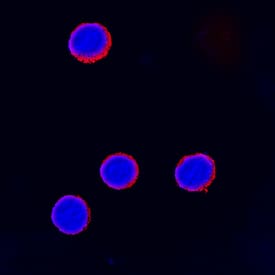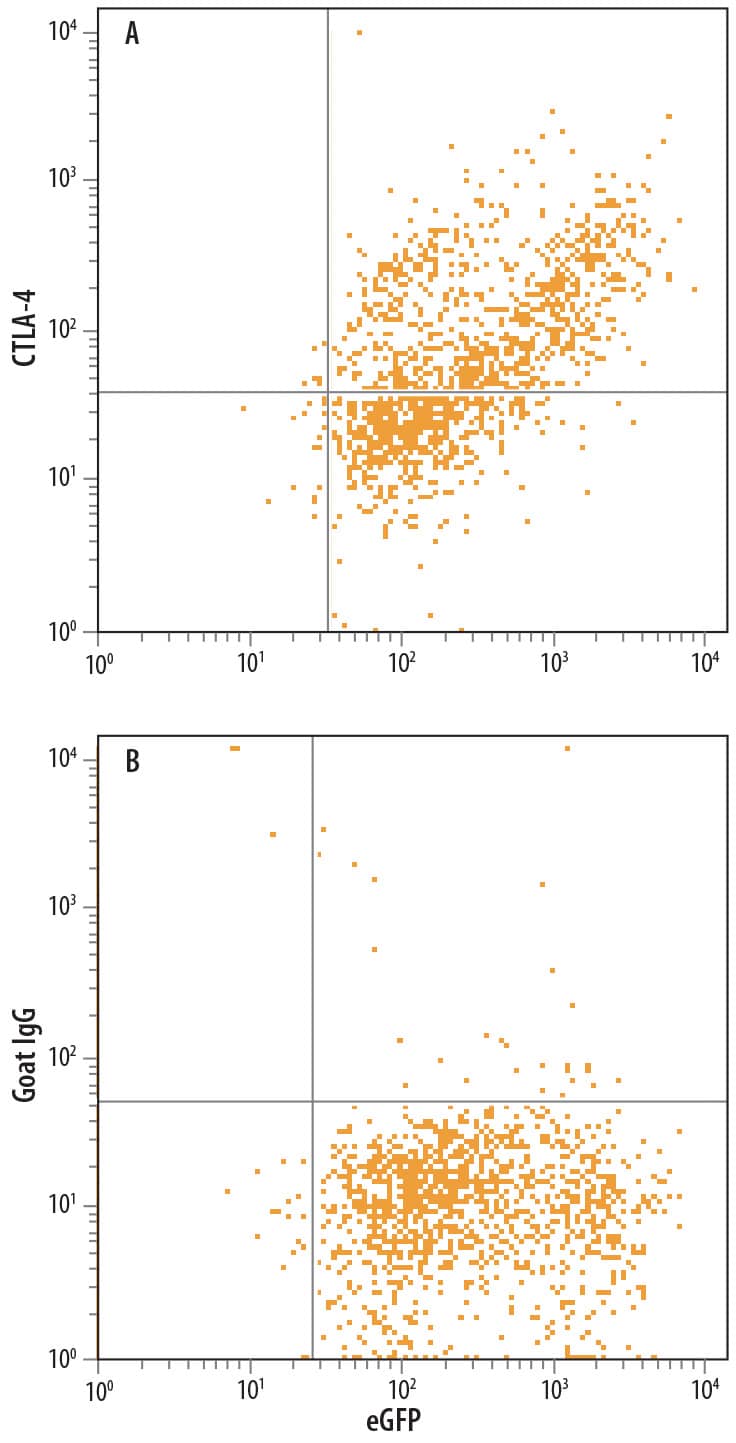Human CTLA-4 Antibody
R&D Systems, part of Bio-Techne | Catalog # AF-386-PB


Key Product Details
Validated by
Species Reactivity
Validated:
Cited:
Applications
Validated:
Cited:
Label
Antibody Source
Product Specifications
Immunogen
Ala37-Phe162
Accession # Q6GR94
Specificity
Clonality
Host
Isotype
Scientific Data Images for Human CTLA-4 Antibody
Detection of Human CTLA‑4 by Western Blot.
Western blot shows lysates of NS0 mouse myeloma cell line either mock transfected or transfected with human CTLA-4. PVDF membrane was probed with 0.5 µg/mL of Goat Anti-Human CTLA-4 Antigen Affinity-purified Polyclonal Antibody (Catalog # AF-386-PB) followed by HRP-conjugated Anti-Goat IgG Secondary Antibody (Catalog # HAF017). A specific band was detected for CTLA-4 at approximately 50 kDa (as indicated). This experiment was conducted under reducing conditions and using Immunoblot Buffer Group 1.CTLA‑4 in Human Peripheral Blood Mononuclear Cells.
CTLA-4 was detected in immersion fixed human peripheral blood mononuclear cells treated with treated with PMA and calcium ionomycin using Goat Anti-Human CTLA-4 Antigen Affinity-purified Polyclonal Antibody (Catalog # AF-386-PB) at 15 µg/mL for 3 hours at room temperature. Cells were stained using the NorthernLights™ 557-conjugated Anti-Goat IgG Secondary Antibody (red; Catalog # NL001) and counterstained with DAPI (blue). Specific staining was localized to cell surfaces. View our protocol for Fluorescent ICC Staining of Non-adherent Cells.Detection of CTLA‑4 in NS0 Mouse Cell Line Co-transfected with CTLA-4 and eGFP by Flow Cytometry.
NS0 mouse myeloma cell line co-transfected with human CTLA-4 and eGFP was stained with either (A) Goat Anti-Human CTLA-4 Antigen Affinity-purified Polyclonal Antibody (Catalog # AF-386-PB) or (B) Normal Goat IgG Control (Catalog # AB-108-C) followed by Allophycocyanin-conjugated Anti-Goat IgG Secondary Antibody (Catalog # F0108).Applications for Human CTLA-4 Antibody
CyTOF-ready
Flow Cytometry
Sample: NS0 mouse myeloma cell line co-transfected with human CTLA-4 and eGFP
Immunocytochemistry
Sample: Immersion fixed human peripheral blood mononuclear cells treated with PMA and calcium ionomycin
Western Blot
Sample: NS0 mouse myeloma cell line transfected with human CTLA-4
Reviewed Applications
Read 2 reviews rated 5 using AF-386-PB in the following applications:
Formulation, Preparation, and Storage
Purification
Reconstitution
Formulation
Shipping
Stability & Storage
- 12 months from date of receipt, -20 to -70 °C as supplied.
- 1 month, 2 to 8 °C under sterile conditions after reconstitution.
- 6 months, -20 to -70 °C under sterile conditions after reconstitution.
Background: CTLA-4
CTLA-4 and CD28, together with their ligands B7-1 and B7-2, constitute one of the dominant costimulatory pathways that regulate T- and B-cell responses. CTLA-4 and CD28 are structurally homologous molecules that are members of the immunoglobulin (Ig) gene superfamily. Both CTLA-4 and CD28 are composed of a single
Ig V‑like extracellular domain, a transmembrane domain and an intracellular domain. CTLA-4 and CD28 are both expressed on the cell surface as disulfide-linked homodimers or as monomers. The genes encoding these two molecules are closely linked on human chromosome 2. CTLA-4 was originally identified as a gene that was specifically expressed by cytotoxic T lymphocytes. However, CTLA-4 transcripts have since been found in both Th1 and Th2, and CD4+ and CD8+ T cell clones. Whereas CD28 expression is constitutive on the surfaces of 95% of CD4+ T cells and 50% of CD8+ T cells and is down regulated upon T cell activation, CTLA-4 expression is upregulated rapidly following T cell activation and peaks approximately 24 hours following activation. Although both CTLA-4 and CD28 can bind to the same ligands, CTLA-4 binds to B7-1 and B7-2 with 20‑100‑fold higher affinity than CD28. The physiological role of CTLA-4 in T cell costimulation is currently being studied.
References
- Lenschow, D.J. et al. (1996) Annu. Rev. Immunol. 14:233.
- Hathcock, K.S. and R.J. Hodes (1996) Advances in Immunol. 62:131.
- Ward, S.G. (1996) Biochem. J. 318:361.
Long Name
Alternate Names
Gene Symbol
UniProt
Additional CTLA-4 Products
Product Documents for Human CTLA-4 Antibody
Product Specific Notices for Human CTLA-4 Antibody
For research use only

